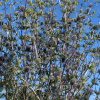Description
Eryngium planum (E. armatum, E. caeruleum, E. intermedium, E. latifolium, E. planifolium) | Flat Sea Holly ‘Blue’
- Seeds harvested September 2023
Sea Holly has been grown in American gardens since the 1800’s. Its an easy-to-grow fancy thistle with beautiful metallic, almost iridescent, bright blue, spiny flowers that sit atop 3-4 ft tall plants.
Sea Holly plants love sunshine and normal or sandy soil, and once established, are extremely drought resistant and require little care. They make great specimen plants for low-water gardens.
The species is hermaphrodite (has both male and female organs) and self fertile. Eryngium plants may or may not flower the first year from seed, but should come back with a vengeance in following years and are valued by many for their prolonged bloom time. If you deadhead them they will keep blooming well into fall. Seeds can self-sow, but not to the point of becoming invasive.
Attracts bees, flies, butterflies, beetles, and other pollinators like crazy! This was our garden-winner for ‘most visited’ by pollinators last year, as well as hosting the most diverse group of pollinators.
If starting seeds indoors, Blue Sea Holly seeds will require a 60 day period of cold-moist stratification before the seeds will germinate. Or if you plan on starting them outdoors you can sow the seeds in the fall and let nature do its thing.
Cold stratification is a term for a procedure that can improve certain seed germination rates by 300-400%. Cold stratification is designed to mimic the winter season’s cold and moist weather that unlocks a seeds protective germination mechanisms and triggers the seed to sprout out of its dormant state. (Most perennial plant seeds (such as native wildflowers) require this combo of cold and damp to germinate.) In nature, this occurs naturally, but by doing the process yourself in a controlled environment, you keep the young seeds safe from any animals that might eat them and they’ll also be less likely to succumb to rot or mildew, leaving more seeds to grow.
There are many methods to cold-stratify seeds, but the two key factors are always moisture and cold. The best and easiest way is to put a small amount of moist/wet sand/soil in a zip baggie and store in the refrigerator for 2 months time (or more). Once stratified, surface sow the seeds (and sand) and gently press into the dirt. Germination will occur with heat humidity and light indoors, or if outdoor, once spring temps and sunlight are adequate. Be sure to plant stratified seeds within a day or so after removing them from the refrigerator because as soon as they warm up they will be ready to grow and may start to sprout. Move seedlings to their permanent location when they are still small because Eryngium have large taproots and resent being transplanted once mature.
Almost all Eryngium make excellent, long lasting cut flowers. Harvest them when the entire flower heads and bracts turn blue so the flowers will keep their beautiful blue color after drying.
Type: Perennial
Sun exposure: Full sun
Mature height: 3-4 ft
Mature width: 18-24 inches
Hardiness zones: 4-9













